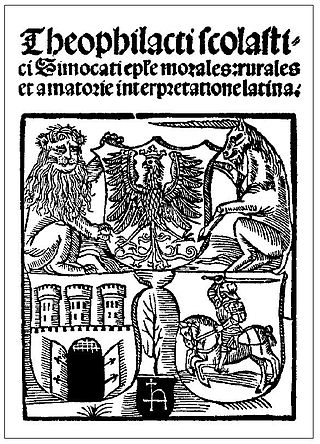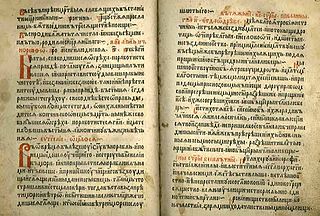
Kołobrzeg, is a port city in the West Pomeranian Voivodeship in north-western Poland with about 47,000 inhabitants. Kołobrzeg is located on the Parsęta River on the south coast of the Baltic Sea. It is the capital of Kołobrzeg County.

Edith Stein was a German Jewish philosopher who converted to Christianity and became a Discalced Carmelite nun. She is canonized as a martyr and saint of the Catholic Church; she is also one of six patron saints of Europe.

Anna Jagiellon was Queen of Poland and Grand Duchess of Lithuania from 1575 to 1587.

Almanach cracoviense ad annum 1474 is a broadside astronomical wall calendar for the year 1474, and Poland's oldest known print. This single-sheet incunable, known also as the Calendarium cracoviense, was published at Kraków in 1473 by Kasper Straube, an itinerant Bavarian printer who worked in Kraków between 1473 and 1476. It has been suggested that the Almanach was written by astronomer Petrus Gaszowiec.

Peter Schöffer or Petrus Schoeffer was an early German printer, who studied in Paris and worked as a manuscript copyist in 1451 before apprenticing with Johannes Gutenberg and joining Johann Fust, a goldsmith, lawyer, and money lender.

The Grand Duchy of Kraków was created after the incorporation of the Free City of Cracow into Austria on November 16, 1846. From 1846 to 1918 the title, Grand Duke of Kraków, was part of the official titulary of the Emperor of Austria.

The global spread of the printing press began with the invention of the printing press with movable type by Johannes Gutenberg in Mainz, Germany c. 1439. Western printing technology was adopted in all world regions by the end of the 19th century, displacing the manuscript and block printing.

Rohr is a municipality in the Schmalkalden-Meiningen district in Thuringia.

Johann Haller or Jan Haller (1463–1525) is considered one of the first commercial printers in Poland.

Schweipolt Fiol was a German-born 15th century pioneer of Cyrillic printing. Fiol spent a considerable part of his life in Poland, particularly Kraków, the capital of the Polish Kingdom at the time. The city was famous for its university. The burgeoning of the arts and sciences contributed to the early emergence of book printing here: as early as 1473–1477 there was a print shop in Kraków, which published numerous theological works. The very first book printed in Cyrillic script, Oktoikh (Octoechos), was published by Fiol in 1491 in Kraków.

Eldena Abbey, originally Hilda Abbey is a former Cistercian monastery near the present town of Greifswald in Mecklenburg-Vorpommern, Germany. Only ruins survive, which are well known as a frequent subject of Caspar David Friedrich's paintings, including the famous Abtei im Eichwald.
Treaty of Prenzlau or Peace of Prenzlau may refer to several treaties during a series of wars between the Margraviate of Brandenburg and the Duchy of Pomerania fought for control of Pomerania-Stettin, and possession of the Uckermark in the 15th century. The First Peace of Prenzlau ended a war fought between 1445 and 1448, while the Second Peace of Prenzlau ended a war fought between 1466 and 1468. In older documents, Prenzlau may be spelled Prenzlow, which was the common spelling during the time period the treaties were drawn and was only changed during the 19th century. Prenzlau is situated in the center of Uckermark.

The history of printing in Poland began in the late 15th century, when following the creation of the Gutenberg Bible in 1455, printers from Western Europe spread the new craft abroad.

Pomerania during the Early Middle Ages covers the History of Pomerania from the 7th to the 11th centuries.
Dierkow near Rostock, Mecklenburg, was a Viking Age Slavic-Scandinavian settlement at the southern Baltic coast in the late 8th and early 9th century. Neither the site itself, nor the adjacent Slavic burghs Kessin and Fresendorf have yet been sufficiently researched.

Hieronymus Vietor was a printer and publisher born in Silesia and active in Vienna and Kraków. Famous for the quality and quantity of his prints, he is considered one of the most important early book printers in Poland, also because he was the first to regularly print in Polish. He is also known as Hieronymus Philovallensis or Hieronymus Doliarius, or in Polish as Hieronim Wietor or Büttner.

Sebastiano Montelupi, was an Italian-born merchant and banker in Kraków, Poland, and Postmaster General of the Polish royal postal service under Sigismund II Augustus, Henry III of Poland, Anna Jagiellon, Stephen Báthory and Sigismund III Vasa.
The Deutsche Gesellschaft zur Bekämpfung des Kurpfuschertums was a skeptical association founded in 1903 for consumer protection against quackery. It opposed the Kurierfreiheit, that existed in Germany from 1869/1872 until the adoption of the Heilpraktikergesetz in 1939. The association originated after the example of the Deutsche Gesellschaft zur Bekämpfung der Geschlechtskrankheiten, and is counted as one of the predecessors of the Gesellschaft zur wissenschaftlichen Untersuchung von Parawissenschaften (GWUP).
Musik und Gesellschaft was a music magazine in the German Democratic Republic. It was published monthly from 1951 to 1990 in East Berlin by Henschelverlag.
Jörg Jarnut is a German historian who was Chair of Medieval History at the University of Paderborn from 1983 to 2007.














